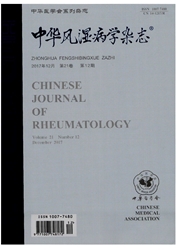

 中文摘要:
中文摘要:
目的探讨原发性干燥综合征(pSS)合并肾脏损害与高丙种球蛋白(IgG)血症的相关性。方法回顾性分析我科住院诊断为pSS并且合并肾脏损害的130例患者的临床和病理资料,比较高IgG与正常IgG两组在临床表现、肾脏损害、免疫学和肾脏病理方面的差异。结果收集130例pSS肾脏损害患者,高IgG组远端肾小管性酸中毒(dRTA)发生率为84%,显著高于正常IgG组(59%)(P〈0.05);肾小管性蛋白尿发生比例在高IgG组为55%,显著高于正常IgG组(21%)(P〈0.05);血IgG水平与血钾浓度呈显著负相关(r=-0.269,P〈0.01);高IgG组以肾小管性蛋白尿为主,正常IgG组以肾小球性蛋白尿为主,两组间差异有统计学意义(P〈0.05);正常IgG组患者低补体发生率显著高于高IgG组(P〈0.05);两组患者肾组织的肾小管间质积分(TI)和肾小球积分(GI)比较差异无统计学意义。结论高IgG血症与dRTA之间存在一定相关性,高IgG血症导致的肾脏损害以小管病变为主,与肾功能损伤程度有关,临床上对于高IgG血症患者要注意检查小管酸化功能。
 英文摘要:
英文摘要:
Objective To identify the correlation between hypergammaglobulinemia (hyper-IgG) and renal involvement in patients with primary Sjogren's syndrome (pSS). Methods The data of all patients admitted to hospital with the diagnosis of pSS were retrospectively analyzed. One way ANOVA and Spearman's correlation analysis were used to compare the clinical characteristics, renal injuries, immunology tests and renal pathological changes between patients with or without hyper-IgG. Results One hundred and thirty pSS cases were enrolled including 8 males and 122 females. Their age ranged from 16 to 68 years with an average of (44±12) years. Forty-one patients with pSS underwent renal biopsy. The preva lenee of dRTA and tubular protein was significantly higher in patients with hyper-IgG than those without(P〈0.05 ). Spearman's correlation analysis showed a negative correlation between serum IgG levels and seral potassium level(r=-0.269,P〈0.01 ). Protein electrophoresis results revealed predominantly tubular protein in the hypet-IgG group, on the other hand glomerular protein was found in the normal-IgG group (P〈0.05). The occurrence of decreased C4 complement concentration was significantly higher in normal-IgG group (P〈0.05); Spearman's correlation analysis for biopsied materials showed that there was no significant difference in the Tubular Index (TI) and Glomeru- lar Index(GI) between these two groups. Conclusion Tubular lesions, especially dRTA, may be predominant and correlate with hypergammaglobulinemia. There is a correlation between hypergammaglo-bulinemia and the level of renal lesions. Renal acidification capacity in patients with hypergammaglobulinemia should be evaluated.
 同期刊论文项目
同期刊论文项目
 同项目期刊论文
同项目期刊论文
 Identification of Five Novel Variants in the Thiazide-sensitive NaCl Cotransporter Gene in Chinese P
Identification of Five Novel Variants in the Thiazide-sensitive NaCl Cotransporter Gene in Chinese P 期刊信息
期刊信息
